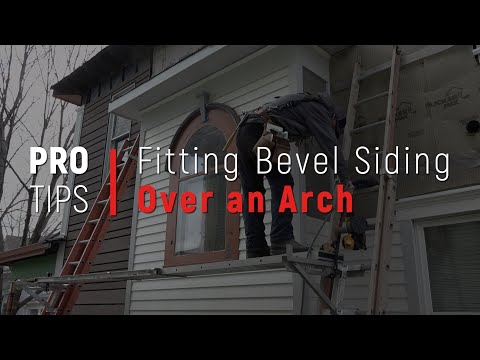It’s not hard to see the appeal of cladding systems like stucco, which are basically liquid-based and flow, or at least smoosh, their way into tricky nooks and around complicated profiles.
Like this CLASSIC head casing profile above this door in Minnesota.
But that’s only where the challenge begins on this one particular piece of bevel siding that needs to fit between two vertical trims, over the door, and under a cantilevered bump-out.
Oh yeah, and the top of the door casing slants off at each end.
The notching process begins with a full bucket of patience
Step 2 is to draw a map of the terrain to be covered. It doesn’t have to be pretty, but it does have to be accurate. One critical piece of accuracy is double-checking things.
Another is having an intelligent system of operations, like pulling numbers from the same place for the whole workpiece, scribing both sides of an obstruction, and drawing known spots for reference.
Of course, a lovely and flat work surface is helpful, but you know, it’s a jobsite.
Transfer the numbers to the siding piece and double-check things as you go. The thing about complicated pieces like this one is that every step you get closer to the finished product adds more to lose if you make a mistake.
Working left to right, Sol transfers the measurements to the siding, and then working right to left, he draws in the main edges.
Make sure the marks are correct before cutting the siding
After double-checking to make sure where he ends is where he thinks he’s gonna end, Sol strolls back to the workpiece to draw the cutouts between the reference marks.
A section is cut out from the top of the siding for the bump-out, and a section od cut out of the bottom of the piece to notch over the door.
Maybe if he had a flat work table, he’d use a chalk line to snap this, but instead, he draws it in with a straightedge and a sharp pencil.
Did I mention how much we all love classic molding profiles?
Sol scribes the profile after aligning it with his reference mark then cuts it out with a jigsaw.
This works out OK, but he opts for a coping saw on the second side.
With the profiles at the ends of the doors cut, he rips the section down to width using a circular saw.
Now it starts getting dicey. There is a lot of work invested in this piece, and there is still some work to do. If it breaks while moving it around, it means going back to square 1. Or two-piecing the siding in this instance.
At the chop saw, he cuts the vertical edges of all the notches, tilting the workpiece to flatten the blade’s curve at the ends of the notches.
He finishes the notch cuts with a utility knife, cleaning up the cuts so they’ll fit tightly.
It’s not a bad idea to back bevel these cuts slightly to make sure the face fits snuggly.
Similarly, he cuts the edges of those tricky profiles, and then he cleans up the edge with a bit of sandpaper.
Test fit the notched siding and adjust the edges for a perfect fit
Now it’s time for a test fit. To see how close this comes to perfection, they walk it over and slip it in place. Again, the cost of breaking it at this point is orders of magnitude greater than the cost of breaking it earlier in the process.
Sitting in place, it looks like the edges of the head casing need to be slightly adjusted. Other than that, it seems to fit.
Sol eases the edges with a mini belt sander.
Sol previously left out that last long cut, the top of the head casing, which slopes down.
So he makes that long cut with a circular saw and cleans up the edges with a multi-tool.
Now they are ready to plop it back into place. It seems to fit after a little gentle nudging, and it’s time to nail it off. The wide parts of the siding can be nailed with a regular coil nailer; the skinny part over the door will be nailed carefully with a finish nailer.
And that’s all there is to notching like a boss. Take your time, measure carefully, make a map, and double-check your numbers before cutting up the workpiece.
This video was shot on location at the international headquarters of OA Design + Build + Architecture as part of Building Resilience, season two.











